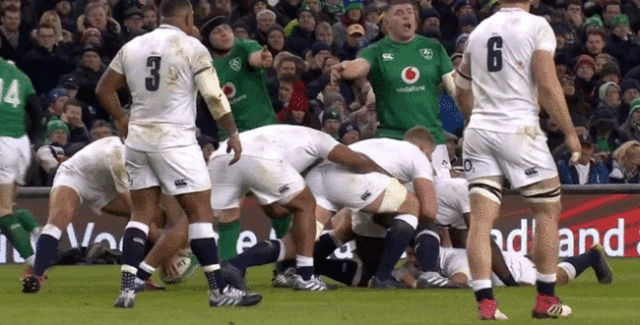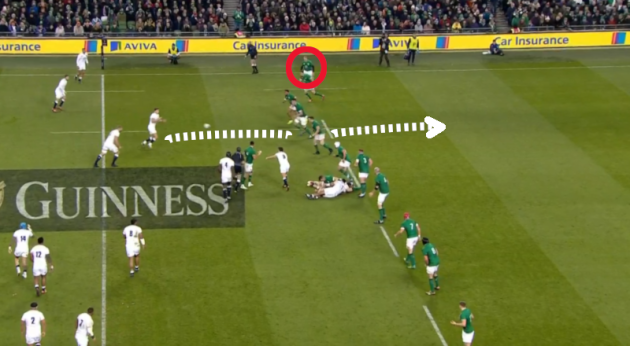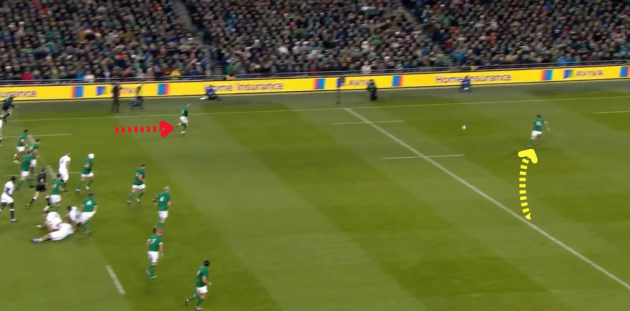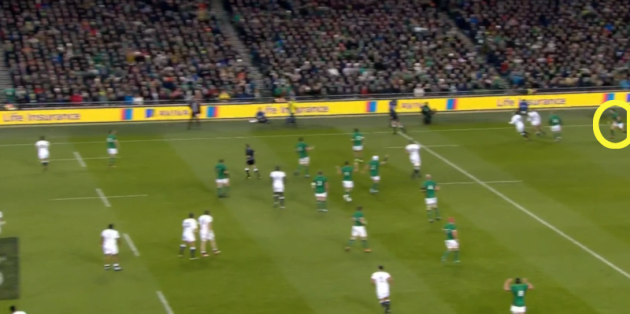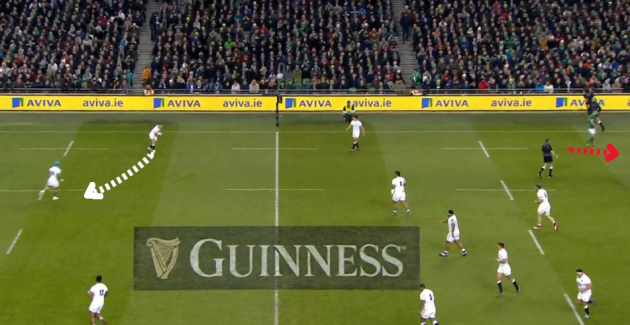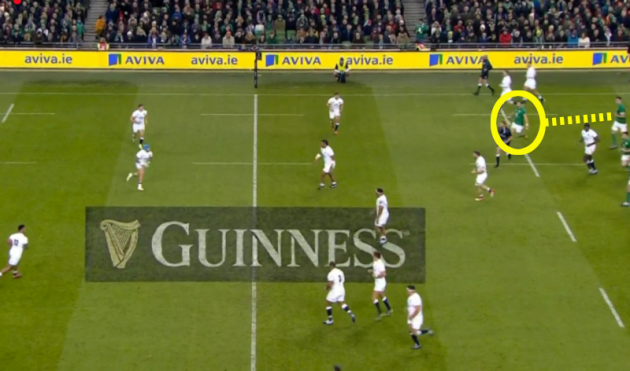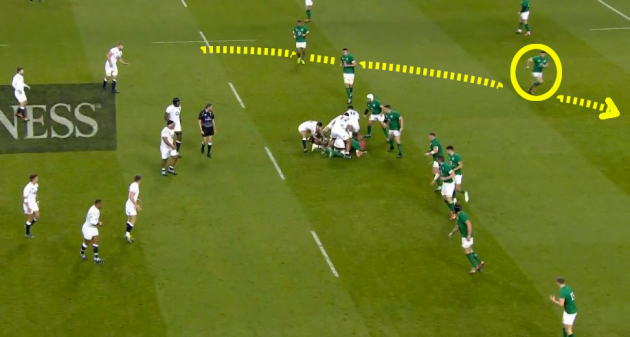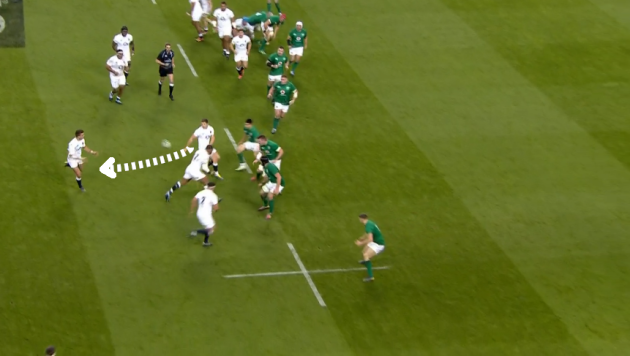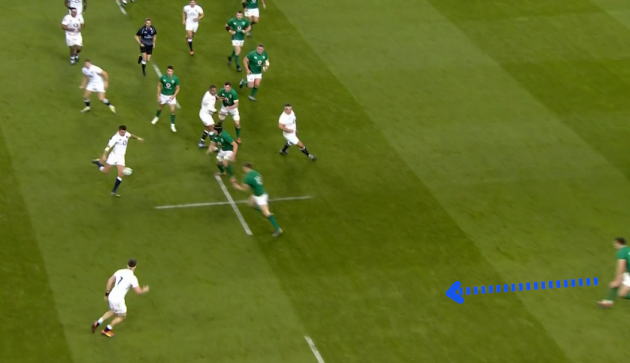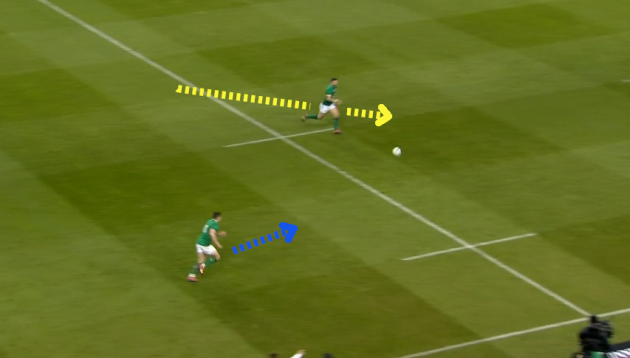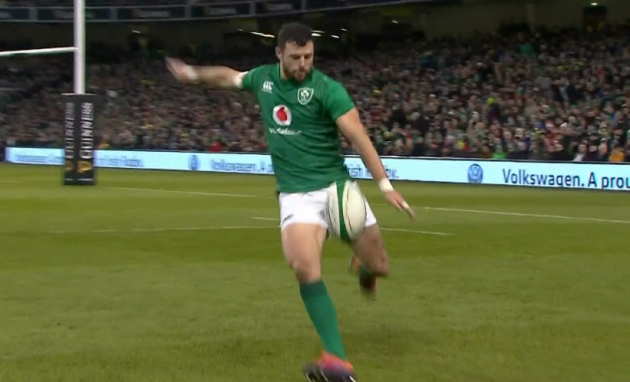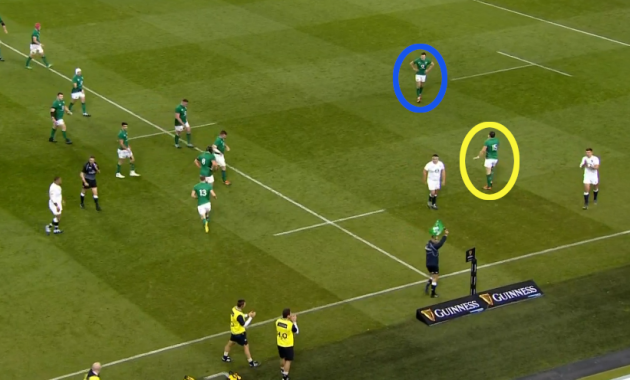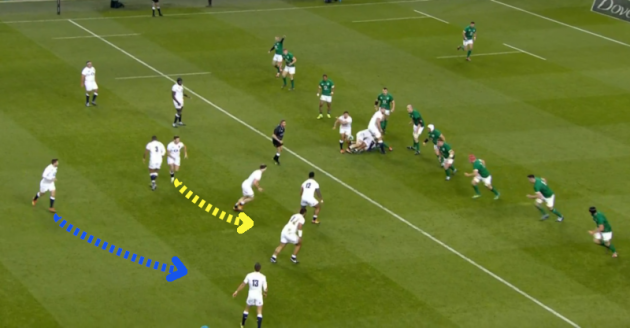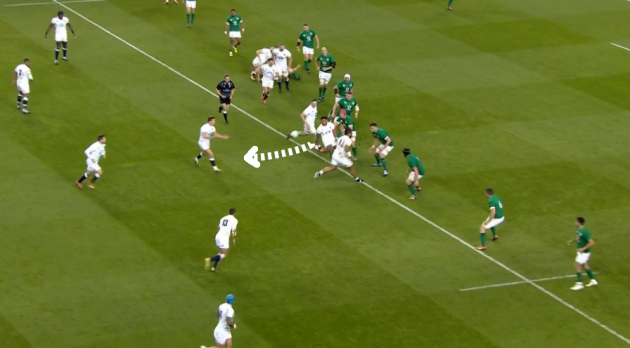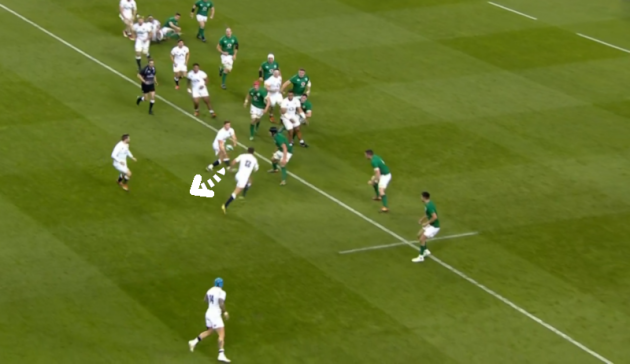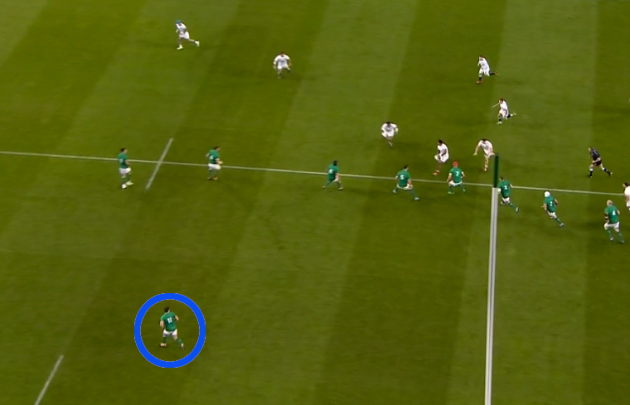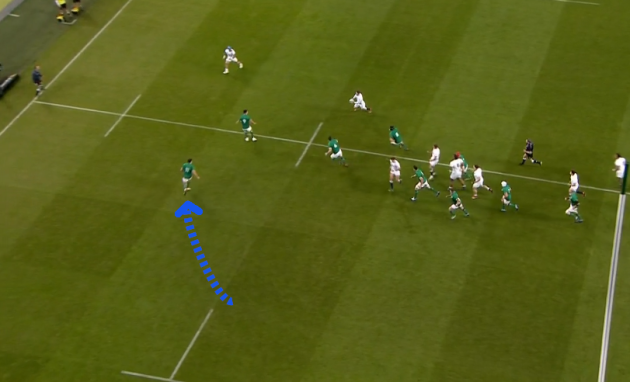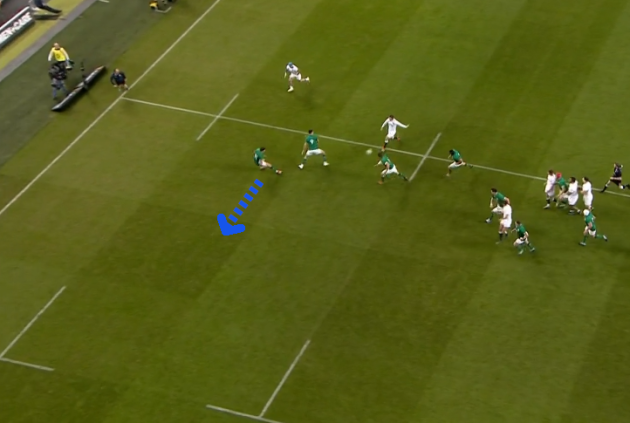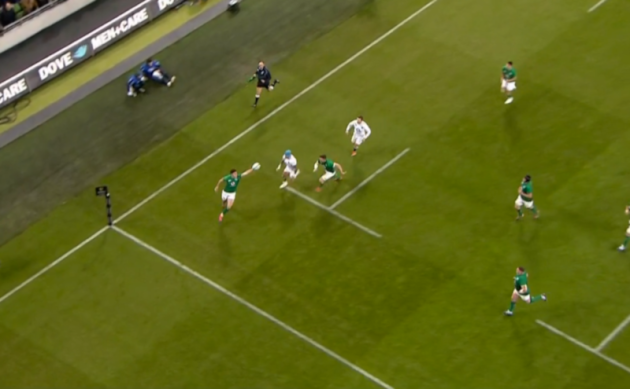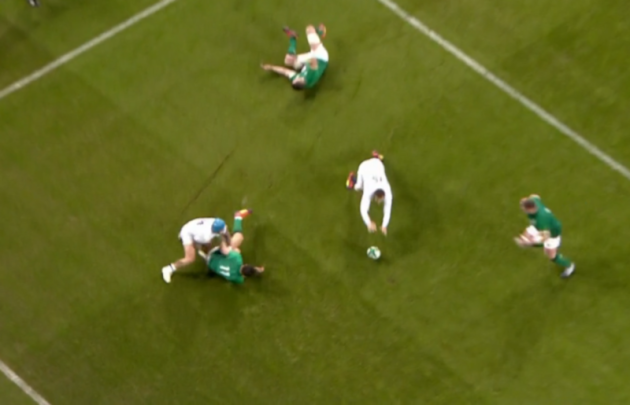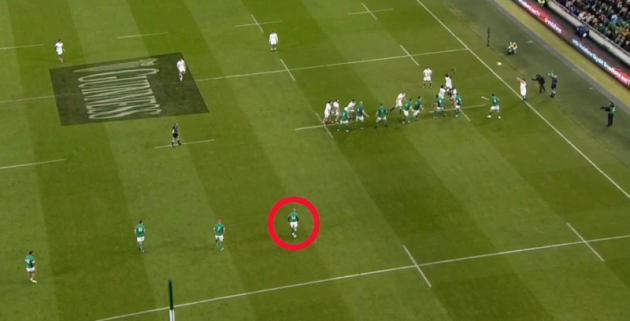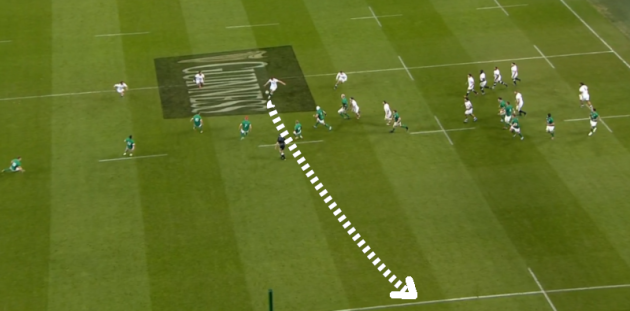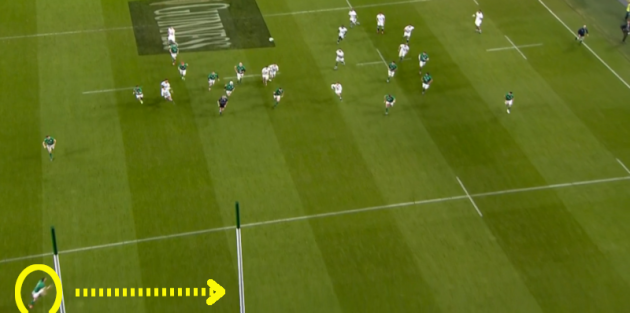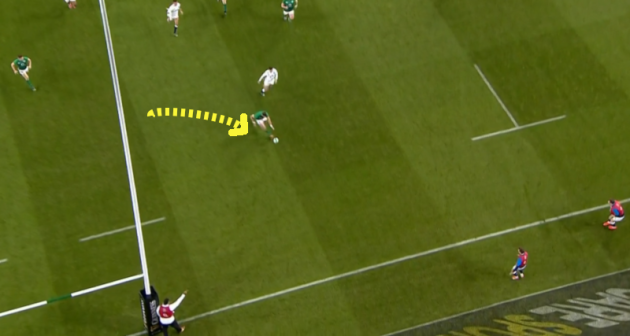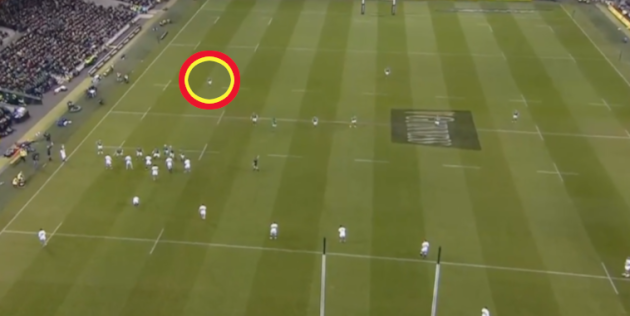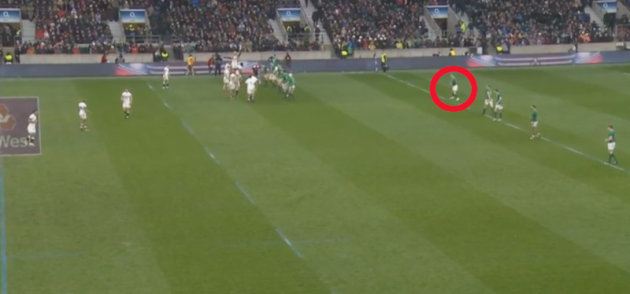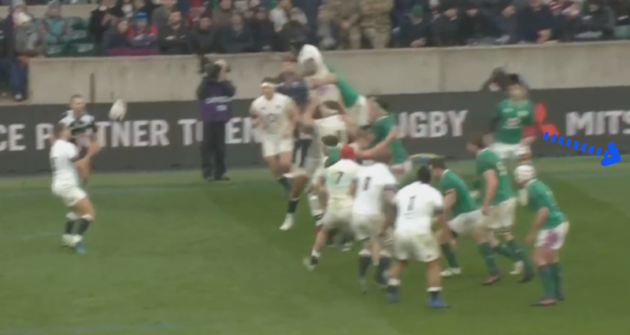IRELAND WERE WELL aware that England would bring a kick-heavy approach to yesterday’s Six Nations encounter in Dublin.
Last season’s Six Nations saw England kick from hand an average of 24.4 times per game, behind only Wales on 27.8.
November saw England’s average rise to 29.5 per game, again second only to Wales’ 29.8 among the top nations.
Against Ireland, Eddie Jones’ team kicked from hand 33 times, primarily through halfbacks Ben Youngs [17] and Owen Farrell [9] but also with important contributions from Jonny May, Henry Slade and Elliot Daly.
It’s important to note that these relatively high figures of kicking include attacking kicks designed to create try-scoring opportunities or pressure the opposition into errors – it’s not all about lumping the ball back to the opposition without attacking intent.
As we noted in an earlier piece on Saturday’s game, England launched high kicks over centre-reverted-to-fullback Robbie Henshaw, designed to bring him into demanding situations he simply hasn’t been in for several years.
Click here if you cannot view the clip above
We get another example above as scrum-half Youngs hangs up a box kick for Henshaw to deal with.
Henshaw gets little help from his team-mates here as England left wing Johnny May is allowed an entirely unimpeded chase of the ball and beats Henshaw one-on-one in the air to give his team fresh impetus.
There was far more to England’s kicking game than these contestable box kicks, though, with Jones’ team scoring two tries as a result of attacking kicks and setting up the platforms for attacking chances with their intelligent use of the boot.
One of the best examples arrived in the 29th minute when Henshaw sliced the ball into touch to give England an attacking lineout in the Ireland 22, from where they scored their second try.
The build-up to Henshaw’s slice is worth examining as evidence of England’s intellect in Dublin.
After receiving an exiting box kick from Conor Murray, England have gone through nine phases of attack against some outstanding Ireland defence on their 10-metre line, when out-half Farrell opts to kick.
As Youngs passes to Farrell and just before the England out-half’s kick [indicated in white above], we can see that Ireland right wing Keith Earls [red] is up in the defensive frontline.
Ireland’s defensive system means their wings spend lots of time in the frontline, rather than hanging deeper in the backfield to cover potential kicks.
Earls and left wing Jacob Stockdale do drop into the backfield at times but Ireland’s intent to bring great linespeed under defence coach Andy Farrell means they generally operate ‘high’ up the pitch.
That leaves Ireland’s fullback with big areas of grass to cover, a very demanding task that Rob Kearney has performed expertly in recent years. It was always going to be one of the most challenging aspects of Henshaw’s switch to fullback for this game.
As we can see above, Earls [red] turns and begins to track back as soon as it becomes clear Farrell will kick – a low, long grubber down Ireland’s right-hand side.
Henshaw [yellow] has to work hard across the pitch to get to the ball, having had so much ground to cover in behind.
As Henshaw gathers the ball, he finds himself in a position he’s rarely been in over the last two years – five metres from the touchline and just over five metres out from his own tryline…
England’s chase of Farrell’s kick is not particularly aggressive but Henshaw is still in an uncomfortable place and that is reflected in the quality of his kick.
Even with the tight angle, the Ireland fullback has time to steady himself here but is slightly rushed and makes a poor connection with the ball, failing to send it into the safety of touch.
There is some possibility that Henshaw [circled in yellow above] intends to keep the ball in play but with his entire team in front of him and essentially offside, he is the only one in position to chase his kick.
As Farrell fields Henshaw’s kick inside the England half and gets set to pass infield [white below] for Jack Nowell to launch the kick return, we can see that Ireland have no chase in place.
Indeed, Johnny Sexton is the Irish player furthest upfield and is still retreating [red] as referee Jerome Garces keeps his eyes peeled for an offside offence.
With Nowell coming back at Ireland, Henshaw [yellow below] has to sprint all the way beyond his team-mates to bring them onside.
Henshaw has now already had two high-speed sprints in this passage and will soon be asked to produce another fatiguing effort.
Nowell carries into the midfield on Ireland’s 10-metre line and we can see below that Henshaw is once again in motion as England recycle.
Henshaw is aware of the kick threat posed by England once again and has to work hard to return to the backfield to cover the kick space.
Perhaps Keith Earls – who departed injured at half-time – could have filled into this role for Henshaw, given how the fullback has already had to work upfield?
Speaking post-match, Ireland boss Schmidt outlined why this might not have been the case.
“Keith, for 20 minutes, was keen to run off the hip pointer [injury] but you can’t really run those off, so he was a little bit under pressure to cover the space and take responsibility for his side of the pitch.
“So Robbie had to almost double-job at times and I thought the volume of running he did, I thought he was as good as he could have been.”
With hindsight, it would be interesting to know if Schmidt and his coaching team regret not replacing Earls earlier given that he physically couldn’t perform the duties required by the team – particularly if Schmidt believed it was an injury that could not be “run off”.
As it is, Henshaw has to get on his bike again as England play off the midfield ruck.
Farrell could kick again here, but Stockdale is hanging in the backfield initially so it’s not on for the England 10 himself to kick.
Instead, Farrell passes out the back door of two forwards runners to second receiver Henry Slade – in the kind of position that helped others to make gainline carries at other times.
The beauty of Farrell hitting Slade is that it draws Stockdale [blue below] up towards the frontline as Ireland’s left wing worries about the wide attack.
As we can see above, Slade is already firing off a grubber kick on his right foot.
Slade is predominantly left-footed but he finds laudable accuracy with this teasing grubber in between Stockdale and Henshaw.
Henshaw gets across to the bouncing ball – deliberately kept infield by Slade to pressure Ireland – and again finds himself in an uncomfortable and even more unfamiliar situation.
Henshaw is right-footed but now finds himself tight to the left touchline, the worst case scenario.
Henshaw is highly fatigued after covering huge ground in the last 30 seconds or so.
His reaction is not a calm and controlled one as he opts to kick on his left foot, slicing the ball off the outside of his boot and into touch inside the Ireland 22.
Henshaw is evidently frustrated and turns infield to offer an apology to Stockdale, who had worked to get inside Henshaw and give him an option to pass infield before he opted to kick.
England’s superb manipulation of the Ireland backfield presents them with a lineout platform inside the Ireland 22 and Jones’ side took full advantage with a try through Daly.
The English were extremely clinical with their entries into Ireland’s 22 on Saturday, with Simon Gleave of Gracenote Sports‘ analysis showing they came away with points from five of their six visits.
It was intriguing that another excellent kick teed up this score, less than a minute after Slade’s effort had ensured the platform.
England hit up in midfield through Manu Tuilagi on first phase, before Mako Vunipola carries around the corner off Youngs on phase two. The third phase of the attack sees England strike and this time, they kick off third receiver.
Schmidt’s Ireland were, surprisingly, outcoached by Jones’ England in terms of set-piece attack in this game and this is a fine example of the English quality.
England bounce back against the grain – as they did several times in this game – with Farrell [yellow] and Daly [blue] in motion sweeping behind the ruck.
Tuilagi, more than just a carrying threat, is in the middle of a three-man pod and after a couple of steps square upfield, he swivels and hits Farrell out the back…
… before Farrell pulls a screen pass behind the hard-running Slade to Daly…
England ran these kinds of pullback plays effectively against Ireland, with the back-door options staying tucked inside the ball until the pass was released and all front-door options being viable receivers.
That kind of movement stressed Ireland’s defence and forced them into poor decisions.
In this instance, we can see Stockdale [blue below] covering the kick space behind as Tuilagi gets set to pass to Farrell.
By the time Farrell has passed to Daly, we can see below that Stockdale has advanced up towards the frontline – once again worried about the wide attack.
But, as we can see below, that actually leaves Ireland numbers-up on the edge of their defence with three defenders – Peter O’Mahony, Murray and Stockdale – against two attackers in Daly and Nowell.
Daly expertly takes advantage of Stockdale advancing and rolls a left-footed grubber into the space he has vacated.
Stockdale now has to turn and accelerate back towards his own tryline as Nowell gets up to full speed and thunders in behind him.
Stockdale may have expected Henshaw to be in the vicinity of the kick space he leaves behind him but the nature of the bounce-back attack leaves the fullback with major ground to cover across from the far right-hand side.
The well-weighted grubber from Daly – designed to sit up before the tryline – bounces ideally for the English as Stockdale attempts to gather it in, just leaping up to his left side.
Stockdale flicks the ball back down towards his right hand as he crosses the tryline but Nowell engages into the tackle in that same split second and the Ireland wing spills the ball, allowing Daly to dive in for England’s second try.
It’s another masterful exploitation of the Irish defence from England with a kick and we saw something very similar again for Slade’s first try in the second half.
This time it came from a midfield scrum, with Jordan Larmour getting caught tight and giving May time to scamper down the left-hand touchline, draw Henshaw up from the backfield and chip over his head for Slade to follow up and dot down, with Stockdale delayed in arriving across.
As intriguingly, we saw an extremely well-prepared England side take advantage of Ireland’s backfield with a kick directly off a lineout shortly after Daly’s try.
England throw into a seven-man lineout on Ireland’s right-hand side and Schmidt’s men rather oddly opt to bring right wing Earls [red below] up into the defensive front line next to openside flanker Josh van der Flier.
The openside would almost always be in this position when defending against seven-man lineouts, but Earls’ positioning is more unusual.
As soon as Farrell gets on the ball, he fires a kick directly into the exact space that a right wing would usually occupy in defensive situations like this one.
Adding to the unorthodox nature of Ireland’s set-up is the fact that Henshaw is positioned wide on the left of the backfield.
As we can see below, Farrell’s kick means Henshaw has to immediately sprint back across to the right as the ball finds clear grass again.
Henshaw is now into another extremely uncomfortable and unfamiliar situation as he retreats towards the bouncing ball.
May is bearing down on him on the kick chase and we saw how a player as experienced – if inconsistent – as Yoann Huget handled this scenario in France’s defeat to Wales on Friday.
To Henshaw’s major credit, he gathers the ball and does extremely well not to be driven over the tryline.
Ireland regather to exit but an out-of-form Murray misses touch and England apply more pressure, culminating in Mako Vunipola having a possible try ruled out and Farrell instead kicking three points to extend their half-time lead.
It’s a strange defensive set-up from Ireland but this passage is further evidence of England having done their homework.
Ireland do generally keep their blindside wings tucked in behind the lineout in the backfield, as we see below in this same game against England.
However, when the opposition use full seven-man lineouts, Ireland have pushed their blindside wing up into the defensive line in the past.
Intriguingly, one of those was last year’s win over England in London.
Below, we can see Earls setting up in the frontline alongside his openside flanker, Dan Leavy, as England get set to throw into a seven-man lineout.
England look to play off the lineout and we a difference in how Ireland defend.
As soon as the ball comes off the top of the lineout, scrum-half Murray sets off into the backfield [blue below].
Murray starts as the defender in the five-metre channel, but instantly switches focus to covering into the space that is left by Earls being in the frontline.
Ireland also used this defensive set-up on once occasion against the All Blacks in November and in that instance, scrum-half Luke McGrath made the same covering run as Murray does above.
Against England on Saturday, however, Murray did not move to cover the space.
Even as Farrell kicks the ball, we can see that Murray [blue] hasn’t begun working to track into the space.
It’s unclear whether this is due to a change of tactics from Ireland or simply Murray not fulfilling his role but it contributes to Schmidt’s team being under intense pressure once again.
This passage also underlines to us how well-prepared England were and how accurately they manipulated Ireland with their kicking game.
- Originally published 7pm.
Subscribe to our new podcast, The42 Rugby Weekly, here:

